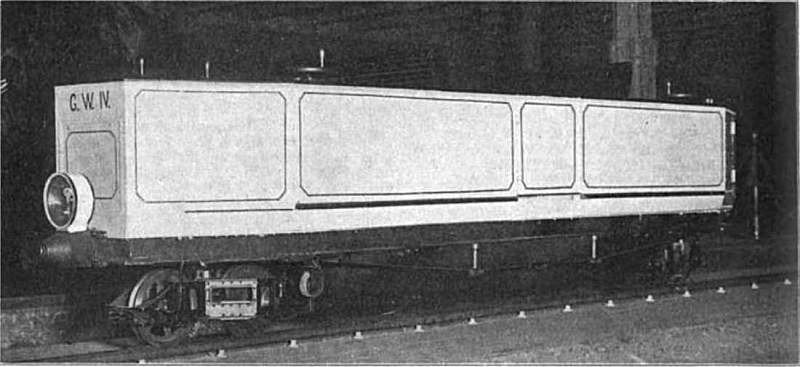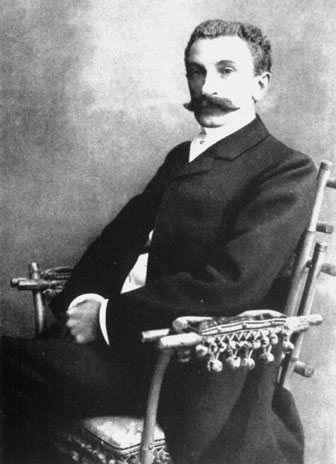Gallery opened: 27 Feb 2015
Updated: 2 Apr 2015
More info, portrait added


The Scherl Gyroscopic Locomotive |
Gallery opened: 27 Feb 2015
|  
|
Shortly after Louis Brennan demonstrated his gyroscopic monorail, the German publisher and philanthropist August Scherl announced a public demonstration of a gyro monorail system that he had developed in Germany. The demonstration was set for Wednesday, 10 November 1909 at the Berlin Zoological Gardens.
If you're not familiar with the mysterious workings of gyroscopes, and few of us are, you may care to look at the Wikipedia gyroscope page, and also the page on gyroscopic precession.
Scherl produced a full size vehicle, 17 ft (5.2m) long, accommodating four passengers on a pair of transverse bench seats. The twin coupled gyros were located under the seats with their axes vertical. (Louis Brennan used a pair of horizontal-axis gyros) Propulsion was by two electric motors. The gyro righting servomechanism was hydraulic, presumably powered by an electric pump. It is believed that August Scherl merely provided the financial backing, and the righting mechanism was invented by Paul Frohlich, and the locomotive designed by Emil Falcke.
Although the idea was well received and the machine performing perfectly during its public demonstrations, it failed to attract significant financial support, and Scherl wrote off his investment in it

| Left: The Scherl Gyroscopic Locomotive on a curve: 1909
|
The following passage is taken from Railway Age Gazette:
"The illustrations herewith show two views of the German gyroscope monorail car, invented by Richard Scherl. This car, shown in exhibitions and trial runs which are now being made in Brooklyn, NY, was referred to in these columns last week."The car has a total seating capacity for six passengers, including the motorman. It is 18 ft long and 4 ft wide and weighs 5,500 lbs, about 5-1/2% of which weight is due to the two gyroscopes. These gyroscopes, which are carried underneath the car body, are operated within steel chambers, the pressure in which is reduced to a vacuum. Each wheel weighs about 110 lbs and revolves at a speed of 8,000 rpm. They revolve In opposite directions and are operated by 115 Volt DC shunt-wound motors, of less than 1/2-HP each. These motors have nothing to do with the propulsion of the car, but affect its stability only. Their ability to maintain the car body in an upright position has been demonstrated in the trials at Brooklyn." "The gyroscope, it is said, will continue to revolve and maintain the car's equilibrium for about an hour after the current is interrupted. Perfect stability was maintained even when a passenger was carried seated upon the side of the car, running at about four miles per hour on straight track and three and one-half miles per hour on curves. On meeting curves, the car would, of course, incline toward the center, but this movement would not take place until the actual curve was reached. There is apparently no provision for the cars being prepared to meet a curve, a detail which would be of greater importance as the speed is increased. It is not possible with the single rail to prepare the car for a curve as is the case when two rails are used." "The car is propelled by two 2-HP, 115-volt, DC series motors, through gearing to the wheels of the two-wheel trucks. These wheels are double flanged to conform to the section of the 20-lb rails. The two current collectors are suspended near the rear wheel of the rear truck, one collector on each side. The two feed wires run along the ties a few inches below the top of the rail. These collectors are shown in the illustrations, as is the general construction of the car body and the truck frames. The truck pin centers are 15 ft apart and the wheels are 12 in in diameter. Inside-hung brakes are provided on each truck. There are four emergency balance rods carrying small rollers which can be dropped to the ground in case of accident. The hand wheels for securing these roller spindles are seen in the illustration." Gyroscope monorail cars of the Scherl and of the Brennan types have been undergoing tests for some time in Germany and England, but the present demonstrations in Brooklyn are the first which have been made in this country." |
Note that they appear to have got Scherl's first name wrong; on the other hand it could be that Richard Scherl was August Scherl's son or other relative, and was entrusted with the leadership of this expedition. The name Richard Scherl is unknown to Google.

| Left: The Scherl Gyroscopic Locomotive: 1909
|

| Left: The Scherl Gyroscopic Locomotive from the side: 1909
|

| Left: Portraint of August Scherl
|

Initial information kindly provided by Kerry Stiff.

  
|